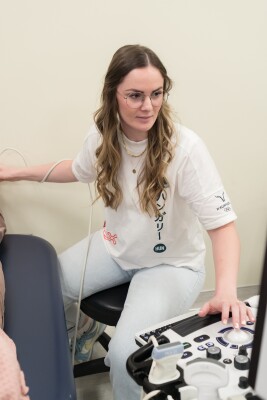Being an anatomy lab manager comes with some unusual responsibilities. Annie Smedley, MS ’24 (EXSC), can be found more than once a semester zipping up a large black bag and recruiting anatomy students to help her carry it out of the Life Sciences Building. She’s used to the funny looks by now. Yet without this admittedly eccentric process, these students—future researchers and medical professionals—would not be able to comprehend how the human body truly functions or increase their awe for God’s hand in each detail.

Back when she was an undergraduate, Smedley was an unlikely candidate for the kind of work she does today. She got a C in the CELL 220 Human Anatomy class, but she loved the material so much that she went on to take EXSC 440, Advanced Musculoskeletal Human Anatomy. Now an anatomy teaching assistant and lab manager, Smedley embodies how far diligence can get you. She shares her academic struggles with students to help them understand that “you can do anything if you work hard... I think it’s inspiring to students to see that the person teaching them had to work hard to get here; it wasn’t just a natural talent.” Smedley especially loves to work with struggling students who want to do better, since she has been in their shoes.
I think it’s inspiring to students to see that the person teaching them had to work hard to get here.
Asking Questions to See Beyond
After starting her master's program, Smedley had to overcome her tendency to focus on the obvious and immediate answers in front of her. Her professors asked questions that prompted her to see the big picture even when studying meticulous details. This skill became critical when Smedley began Achilles tendon research with Dr. Wayne Johnson. While digging through papers to create an annotated bibliography, she noticed that ballet dancers tend to be calorically deficient and experience frequent injuries. “I was so fascinated by that problem,” Smedley shares excitedly. “I couldn’t help but think it had to do with undernutrition.”
The thought evolved into an interdisciplinary project with the electrical engineering and dance departments. Smedley interviewed ballet dancers, scanned their tendons with an MRI machine, and used an ultrasound to track patterns between diet and injury. Shayla Bott, chair of the dance department, advised Smedley on the problems she had noticed in her students, and nutrition professor Dr. James LeCheminant helped Smedley interpret her data.

I care so much for [my dancers], and I want them to see themselves better and be healthier.
“I didn’t expect to care so much about my dancers, my participants,” Smedley confides. “I saw their confidence levels, and I saw how much pain they were in. It just broke my heart sometimes. These beautiful, graceful dancers come into my lab, and then I read their survey responses and think, ‘they don’t see what I see.’ I care so much for these women, and I want them to see themselves better and be healthier.”
The Body is Holy
Smedley understands how her dancers struggle to see their bodies clearly, because her own respect for her body evolved over time. She regrets not learning more about anatomy and human biology in high school, because “learning about the body has made me appreciate mine so much more. It’s really empowering.”

In BYU’s framework securing faith and science together, Smedley sees God’s hand in the way her body works. “I wrote a short paper in a physiology class on how your body produces red blood cells,” she says. “Your body recognizes when it needs more blood cells and signals to produce the specific types of red blood cells… My body knows how to do this because God knew that it needed it and programmed it that way. It’s amazing!”
My body knows how to do this because God knew that it needed it and programmed it that way. It’s amazing!
Approaching the human body with this joyful curiosity allows Smedley to trust that God understands everything, even if she doesn’t. “All the things I’ve learned from chemistry and physics, which I struggled with, to the things I loved learning like anatomy and physiology,” she enthuses, “[taught me] that God is always in the details. Sometimes it’s just so obvious He’s there, but you have to choose to see Him.”
Moving Forward Together
Her work has also expanded her belief in the sanctity of the human body after death. She started coordinating with the Salt Lake City-based body donor program, where the anatomy lab gets their cadavers, for students to write thank you notes. These letters go to the families whose loved ones donated their body to research. “I'm sure that's a hard thing for families not to be able to bury their loved ones,” Smedley considers.
Still, it is through those donations that Smedley and scientists like her are able to continue solving issues affecting the living and improve overall community health. She plans on taking her experiences as the anatomy lab manager forward by becoming a full-time anatomy teacher, and hopes to pass on her enthusiasm to a new generation.